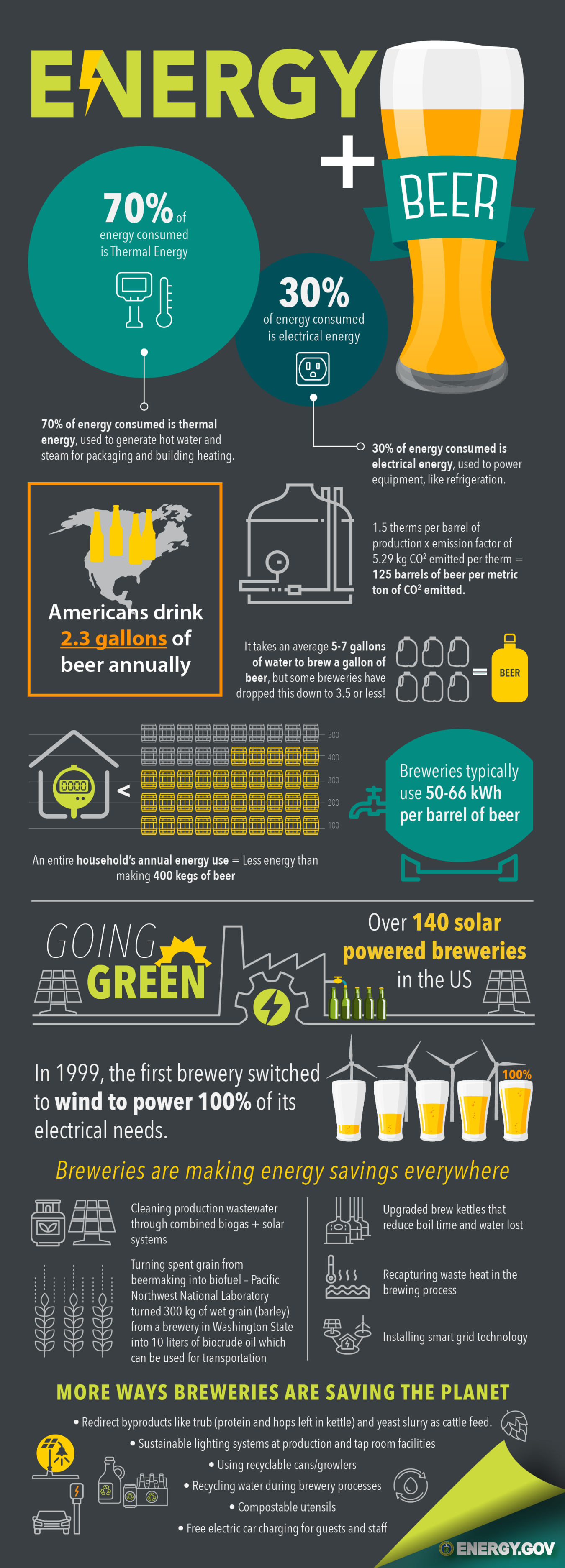To mark National Beer Day (April 7) we’re bringing you some energy stats on what it takes to brew up this beverage and how clean energy is changing the game.
April 7, 2021Energy is critical to those pints, growlers, kegs, and tallboys (& other alcoholic beverages) that the average American adult drinks over 2 gallons of annually. To mark National Beer Day (April 7) we’re bringing you some energy stats on what it takes to brew up ales, stouts, IPAs, lagers, and more, and shed some light on how clean energy is changing the game.
Beer needs energy, from growing the crops that go into the production system – the boiling, chilling, filling cans, cleaning, running production lines, transportation and running HVAC and lighting systems at breweries and tap rooms. We’re talking about 50-66 kilowatt hours needed per barrel of beer. To put this in perspective, the energy to make about 400 kegs of beer could power entire household for a year (stats from the Brewers Association).

Beer production requires some serious cash and has a big environmental footprint. These are motivating factors for breweries to reduce their usage of fossil fuels — from small steps to overhauling their entire energy usage. Our infographic shows some of these actions, like micro turbine systems, rooftop solar, solar canopies, cleaning wastewater for reuse, and installing LED lighting systems.
The U.S. Department of Energy played a part in making some of these changes possible. In 2009, we funded a collaboration with the City of Fort Collins, Colorado on called FortZED — a project to improve the viability of a smart grid, which included the site of a large brewery. The success of the project cut energy costs and helped inspire more smart grid projects.
And there’s more. The DOE is also helping beermakers to find new energy uses like transportation fuel for their spent grain. Pacific Northwest National Laboratory (PNNL) researchers recently achieved a Department of Energy milestone by producing 10 liters of biocrude from 200 kg of low-value, wet, plant-based feedstock, leftovers from the brewing process at a brewery in Washington State. This biocrude can be used in transportation, creating a new meaning on a refreshing beverage.
So while you’re enjoy a frosty beverage of your choosing this Beer Day, and you’re toasting your favorite breweries for making it all possible, just remember how critical the DOE’s clean energy goals are when it comes to quenching your thirst. Cheers!
AnneMarie Horowitz

AnneMarie Horowitz is the Chief of Staff for the Arctic Energy Office. She joined the Arctic Energy Office in May 2023. AnneMarie has been with the Energy Department since 2010, and was previously on the digital team of the Office of Public Affairs, where she managed digital projects and internal employee communications efforts. AnneMarie was the Digital Communications Manager from March 2023 - September 2023 for the Department of Health and Human Affairs' Public Education Campaign, We Can Do This, to share information about the COVID vaccine.
From 2015 - 2017 she served as the Special Advisor on workforce issues for Deputy Secretary of Energy Dr. Elizabeth Sherwood-Randall. She has also previously worked in the Under Secretary for Management and Performance and in the Office of Minority Economic Impact.
AnneMarie has a BA in Political Science from the University of Portland and a Masters of Government from Johns Hopkins University.

